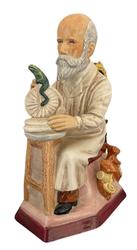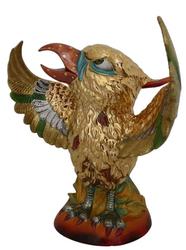News
Peggy Davies Ceramics
Posted On: 24 Jan 2024 by Karyn HarveyPeggy Davies was one of the most influential figurine designers of the 20th century - you can learn more about Peggy and her own ceramics production in this article.

PEGGY DAVIES CERAMICS
Based in Stoke-on-Trent – the heart of the potteries, Peggy Davies Ceramics is a family business whose products are still hand-made and hand-decorated in the traditional way by skilled craftsmen and women.
Margaret (Peggy) Davies was born in Burslem, the so-called ‘mother town’ of the Potteries. She suffered from tuberculosis which she contracted as a young girl and spent much of her young life in hospitals. Despite this she had a sense of humour and a confidence that stood her in good stead. Peggy Davies was sent to live with her grandparents as they were better able to cope with her special needs.
Her grandfather was a working engineer in a local pot bank and lived in a large house attached to the works. Through her family connections Peggy was exposed to the process of pottery manufacture and at the age twelve Peggy won a scholarship to the Burslem College of Art and she studied full time for several years under the tutelage of Gordon Forsyth.
Family circumstances forced her to seek employment before her course ended and she found a part time assistants position with a local ceramic designer called Clarice Cliff. In 1939 Peggy Davies was employed by Royal Doulton as an assistant to Cecil Noke, son of the renowned Charles Noke, and simultaneously set up a small workshop at home.
The Second World War came early to the Burslem factory, when in October 1940 a three-storey warehouse housing finished goods and also the Art Director’s studios were bombed, the factory sustained damage as did many of their employees’ homes. Peggy’s employment with Doulton was interrupted as she decided to join the war effort and become a nurse.
After the war Peggy Davies returned to her first love, she set up a new workshop at home where she worked freelance under contract to Royal Doulton and produced a long stream of new figure models for the Doulton HN series.
Her first figurine study for Doulton was Minuet, HN2019.
The story behind this figurine shows Peggy’s determination to forge her own path. She was not satisfied to simply follow in others’ footsteps. Doulton were pressurising her into producing typical Victorian ladies but she rebelled and produced this Regency style figure.
Another of Peggy’s initial figurines was Janice HN2022, which bears a striking resemblance to a portrait of Lady Jane Grey. Modelling historical characters was a favourite of Peggy Davies.
Janice - HN2022 Queen Elizabeth II
Among her first productions were a handful of ballerina figures, something that had not been created since the early and rare Pavlova, HN487. The delicacy and detail of these ballerinas are synonymous with Peggy’s style and is very distinguishable from other figure modellers.
The first in the series are Coppelia, HN2115 and Ballerina, HN2116. Coppelia is based on the mechanical doll in Delibes’ comic ballet from which the figurine takes her name.
Coppelia – HN2115 Ballerina – HN2116
However, the most accurate ballet figures are the trio that followed these two models. The first, La Sylphide, HN2138 also based on the ballet of the same name. Giselle, HN2139 and Giselle, The Forest Glade, HN2140.
Peggy Davies cannot be labeled as just a lady modeller as she was capable of producing character figures as well. These include the Town Crier, Foaming Quart and The Master. Peggy Davies was famous for her research of the pieces she created. Inspiration for her character figures came from research and real life.
The Master HN2325 she based on her father. She used her husband, Sylvan, as the original for the Town Crier, HN2119. Peggy used her small son Rhodri in his fancy dress suit for Baby Bunting, HN2108 and The One That Got Away, HN2153.
The Master - HN2325 The One That Got Away – HN2153
Peggy Davies had two other sons Gethin and Sylvan and used them for River Boy, HN2128 and Treasure Island, HN2243.
Treasure Island – HN2243
Peggy once said that some of her favourite models were those she based on her family. For 40 years Peggy Davies worked for Royal Doulton on a freelance basis sending in her creations for approval. She was a major creative force at Royal Doulton modelling over 250 figures, a feat unequalled by any other modeller. In 1984 she severed her links with Doulton and set up one of her sons in the pottery business. This allowed her the independence from commercial production and she provided many studies for reproduction. Her artistry was featured in various models within her own Company and in addition to traditional Toby Jugs, include large animal sculptures such as the Hunting Cats, The Otter Group as well as the exquisite Samurai Warrior, The Sultan and the Kublai Khan.
Following the death of Peggy Davies in 1989, Rhodri decided to move the factory to larger premises within the city and commissioned new modellers like Douglas Tootle, Ray Noble, Amanda Hughes-Lubeck and Andy Moss to carry on creating collectable ranges, a policy that continues today.
After the original sculpting the models are then cast in a number of pieces and then hand-assembled before being fired and then moving through the factory to be glazed and hand-decorated. Almost all of the products receive several kiln-fires after hand-decorating sessions to create the different colours and effects required. A process which has long since ceased by other manufactures due to the costs, complexity and a lack of skilled ceramic artists. Kevin Pearson and Francis Salmon established a business in 1987. Kevin Francis ceramics are renowned for their creative and high-quality figurines. Kevin and Francis partnered exclusively with Peggy and Rhodri Davies to produce all their designs through Peggy Davies Ceramics.
All Kevin Francis Peggy Davies products are handmade and hand decorated in Stoke-on-Trent using traditional production methods, with designs modelled and created by some of the best ceramic modellers and artists in the world. This production method means that each figurine is completely unique, all the designs produced are also limited editions. It was during the 1990s that the company really began to come into its own, creating a Toby Jug collection which still proves very popular with British pottery collectors today, as well as starting to develop their first figurines, which were heavily inspired by the Art Deco works of famous designers Clarice Cliff and Susie Cooper.
At the end of 2003 the company moved to its present location in Wellington Road, Hanley. This much larger premises enables all production to be carried out on one site. In 2010 Peggy Davies Ceramics issued a limited edition – Phoenix Series, based on the work of the Martin Brothers. The Phoenix was modelled by Robert Tabbenor. According to The Sentinel, a Staffordshire newspaper, Peggy Davies Ceramics were rising again with the Phoenix Range. (Published in 2010).
As times and trends have changed, Peggy Davies Ceramics has adapted to include many new product lines but, still uses the same traditional hand-skills to make the models created by some of the best freelance ceramic modellers and artists in the world.
Thank you to Christopher Evans for his assistance with this article.


.jpg)

.jpg)
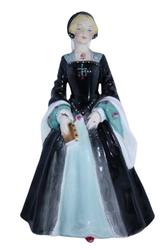
.jpg)
.jpg)
.jpg)
.jpg)
.jpg)
.jpg)
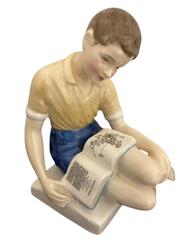

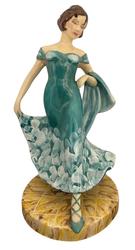
.jpg)
